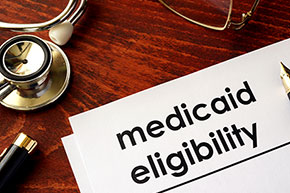How Does Medicaid Eligibility Impact Saving?

The impact of public insurance programs on a family’s saving habits has become a key question as Medicaid rolls have grown due to the Affordable Care Act (ACA) and as the personal savings rate continues to decline.
A recent In the Balance article explored whether low-income families who became eligible for Medicaid saved more of their tax refund. The analysis of survey data found those in financial stress chose to save more, while low-income households that weren’t in as much financial distress did not significantly alter their saving plans.
“It turns out that becoming eligible for Medicaid tends to mean a little more money in the bank for low-income families in financial stress: They planned to save about $93 more of their tax refund, on average,” wrote Emily Gallagher, visiting scholar at the Center for Household Financial Stability at the St. Louis Fed.
Gallagher highlighted her recent working paper Sabat, Jorge; Gallagher, Emily; Gopalan, Radhakrishnan; and Grinstein-Weiss, Michal. “Medicaid and Household Savings Behavior: New Evidence from Tax Refunds.” Working Paper. May 16, 2018. https://ssrn.com/abstract=3052026 or http://dx.doi.org/10.2139/ssrn.3052026 with co-authors Radhakrishnan Gopalan, Michal Grinstein-Weiss and Jorge Sabat. In the paper, they identified financially stressed families using an index constructed from five indicators of financial difficulty, such as whether a household had missed a home payment or had a credit card declined in the past six months.
Meanwhile, low-income families that are less financially distressed did not appear to significantly alter their savings behavior in response to Medicaid eligibility, she noted.
“Together, these findings signal that the ACA’s Medicaid expansion is unlikely to negatively affect low-income household savings rates,” said Gallagher, who is an assistant professor of finance and real estate at the University of Colorado at Boulder.
Decline in Savings Rate
Overall, the personal savings rate in the U.S. has fallen since the 1960s. The savings rate was 6.5 percent in October 2017, compared with 10 percent in September 1960, according to the U.S. Bureau of Economic Analysis.
The drop in the savings rate may be attributed to a number of causes, but of particular interest was understanding the effect of public insurance programs such as Medicaid, unemployment and disability, Gallagher noted.
This is particularly important following the implementation of the ACA in 2014. An additional 16.3 million people were added to the Medicaid rolls from the act’s passage through October 2017. That means about 21 percent of the U.S. population now receives health insurance coverage through Medicaid, the article pointed out.
Income Eligibility for Medicaid Varies Greatly
State eligibility limits for Medicaid changed very little from 2010-13, the article said, but the limits changed dramatically following the implementation of ACA.
“We took advantage of a natural experiment created when some states opted to expand Medicaid eligibility under ACA, while others did not, which allowed us to contrast savings behaviors,” Gallagher wrote, referencing the working paper.
In the paper, the researchers used a database of survey responses from 67,000 low-income households, which included data such as the size of the tax refunds they received, their plans for using the refunds and financial distress measures. Gallagher noted that it also allowed the researchers to distinguish which families are eligible for or receive Medicaid.
Struggling Families Save More with Eligibility
The key observation from the working paper, Gallagher noted, was that the most financially stressed families plan to save or pay down debt with a larger share of their tax refund once they become eligible for medical coverage under Medicaid.
“These households reported that they intended to put 4.4-percentage points more of their tax refund toward savings or debt repayment. That equates to a roughly 7 percent increase in the rate of refund savings or debt repayment (the average rate among financially constrained households is 67 percent),” Gallagher wrote. “It also equates to almost $100 less in intended near-term consumption.”
While financially distressed families planned to save more when eligible for Medicaid, Gallagher noted that she and her co-authors observed something different for low-income families who were not financially stressed. “In contrast, eligibility seemed to make no difference in savings rates for the average low-income household that did not meet these stress criteria,” Gallagher said.
In the next blog post, we will examine the possible reasons why Medicaid eligibility impacts saving plans of those who are financially stressed differently than those who aren’t.
Notes and References
1Sabat, Jorge; Gallagher, Emily; Gopalan, Radhakrishnan; and Grinstein-Weiss, Michal. “Medicaid and Household Savings Behavior: New Evidence from Tax Refunds.” Working Paper. May 16, 2018. https://ssrn.com/abstract=3052026 or http://dx.doi.org/10.2139/ssrn.3052026
Additional Resources
Citation
ldquoHow Does Medicaid Eligibility Impact Saving?,rdquo St. Louis Fed On the Economy, Dec. 11, 2018.
This blog offers commentary, analysis and data from our economists and experts. Views expressed are not necessarily those of the St. Louis Fed or Federal Reserve System.
Email Us
All other blog-related questions

